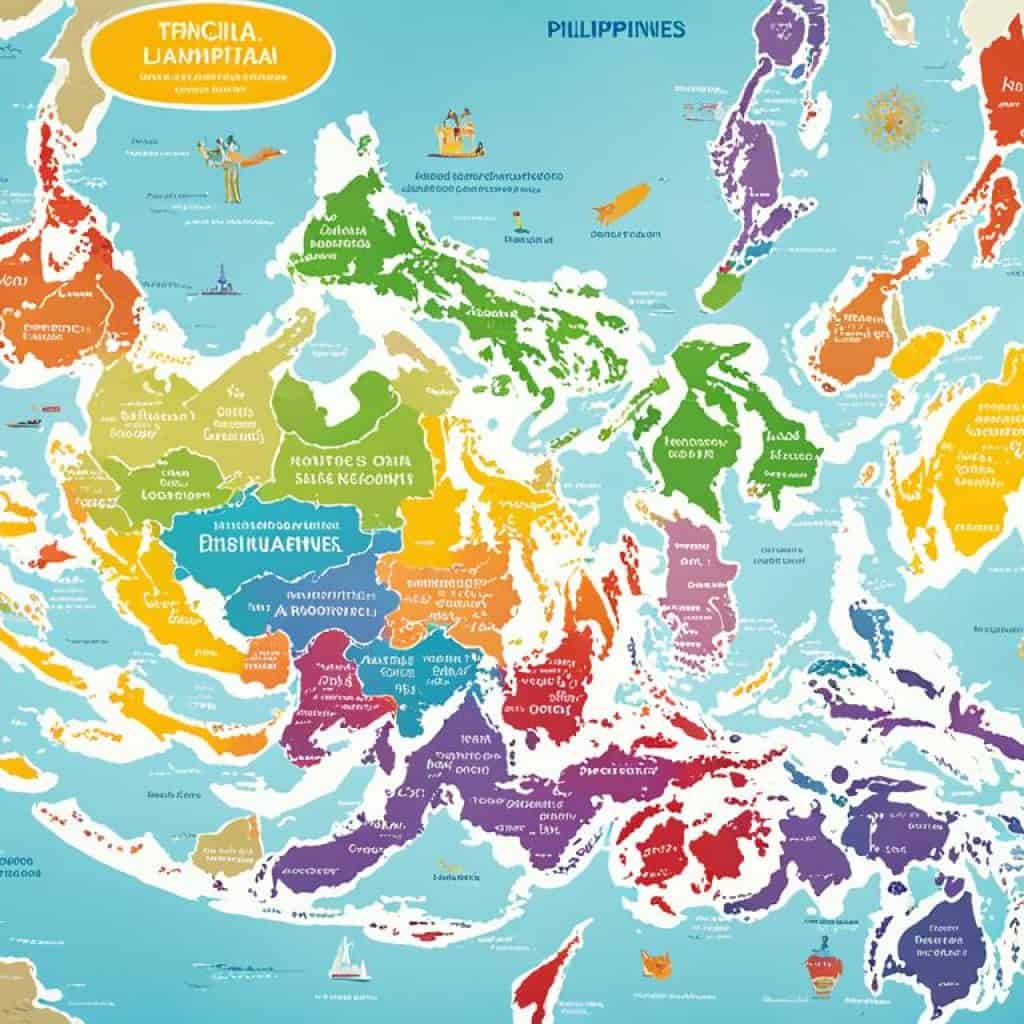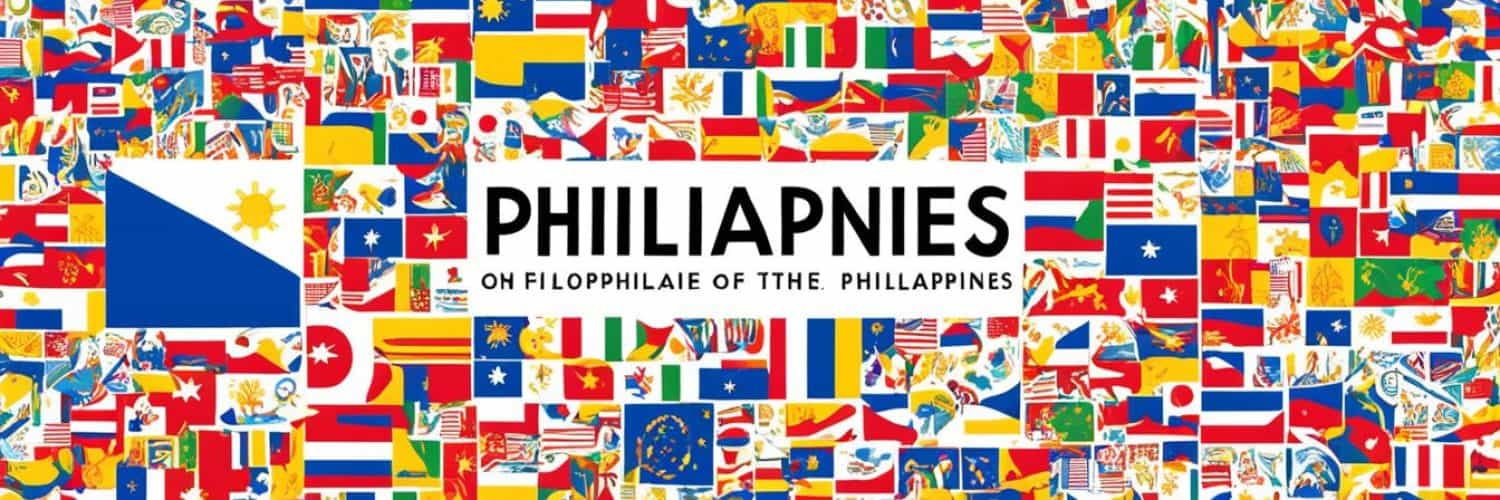Ever wondered about the languages spoken in the Philippines? This country is rich in linguistic diversity, showcasing a fascinating mix of languages. These reflect its deep cultural heritage. But, what are the official languages here? And why are they so important? Let’s explore the Philippines’ official languages and their significance.
Key Takeaways:
- The official languages of the Philippines are Filipino and English, both of which enjoy equal status.
- Filipino is based primarily on Tagalog and is the national language of the Philippines.
- English is widely spoken and used in various aspects of society, including government, education, and business.
- Aside from Filipino and English, the Philippines is home to a diverse range of indigenous languages, totaling over 180 recognized languages.
- Language preservation efforts are essential for maintaining the cultural heritage and linguistic diversity of the Philippines.
Filipino Language
The Filipino language is the national language of the Philippines. It plays a big role in the country’s language scene. The language is mainly based on Tagalog, spoken by over 50 million Filipinos.
For most Filipinos, it’s their first language. It acts as a second language for others.
Filipino shows the Philippines’ diverse culture and rich heritage. Its vocabulary, grammar, and growth have been shaped by different cultures. These include Chinese, Malay, Spanish, and American influences.
“Filipino is more than a language; it is a symbol of national unity and identity. It embodies the collective history, values, and aspirations of the Filipino people.”
Filipino is spoken not just in the Philippines but around the world. It connects Filipinos living abroad to their cultural roots. This is especially true in the United States, Canada, and Saudi Arabia.
Language Characteristics
Filipino is similar to other Philippine languages but also unique. It has borrowed words from English and Spanish. These words are now a big part of daily Filipino speech.
As the national language, Filipino helps promote bilingualism in the Philippines. English is used for business, education, and government. But, Filipino brings people together, giving them a sense of national identity and pride.
The Role of Filipino Language
The Filipino language is important in many aspects of life in the Philippines. It’s used in education, media, literature, and government. Schools teach subjects in Filipino, helping students become good at both Filipino and English.
Filipino is also a key medium for art. Many important works in literature, film, and music are in Filipino. It helps preserve and promote the culture and heritage of the Philippines.
| Key Points about Filipino Language |
|---|
| 1. Filipino is the national language of the Philippines. |
| 2. It is based primarily on Tagalog. |
| 3. The Filipino language has been influenced by various cultures such as Chinese, Malay, Spanish, and American. |
| 4. It serves as a symbol of national unity and identity for the Filipino people. |
| 5. Filipino is widely used in education, media, literature, and government documentation. |
English Language
English is very important in the Philippines. It’s an official language and widely used in government, education, and business. Many people speak and understand it, making communication easy.
The English language’s role in the Philippines started during American colonization. It became the medium of instruction and administration’s language. This period greatly influenced the country’s education system and the use of English.
Knowing English well is valued in the Philippines. It helps in global communication, business, and getting good jobs. Students learn English in schools and universities to be competitive in the job market.
The use of English has helped the outsourcing industry in the Philippines grow. It’s now a top choice for businesses that need English-speaking staff like customer service agents and virtual assistants.
“English is more than just a language in the Philippines. It’s a tool for empowerment and economic growth, helping Filipinos connect globally and join the international community.”
The Impact on Education
English is a key part of education in the Philippines. It’s used from primary to tertiary levels, along with Filipino. This ensures students are bilingual and ready for local and global interactions.
Using English in schools prepares students for studying abroad. It also gives them access to many academic resources in English. This makes them competitive in the global job scene.
Language in Government and Business
The government also uses English in the Philippines. Official papers and public messages are often in English. This makes communication clear and governance transparent.
In business, English is the main language for communication with international partners. It brings in foreign investments and supports global trade. Being fluent in English can boost career growth.
Bilingualism and Cultural Exchange
Being fluent in Filipino and English has shaped a unique cultural identity for Filipinos. It has fostered exchange between the Philippines and English-speaking countries. This exchange brings different ideas, traditions, and art into the Philippines.
English lets Filipinos enjoy and take part in global culture. They experience world literature, music, movies, and more. This exchange enriches cultural understanding and diversity.
English: A Language of Opportunity
English symbolizes progress and opportunity in the Philippines. It links Filipinos to the world. English proficiency is crucial for education, career success, and engaging in the global scene.
Next, we’ll look at the Philippines’ indigenous languages and their cultural value.
Indigenous Languages
The Philippines is rich in indigenous languages, apart from Filipino and English. These languages come from various ethnic groups and tribes. The country boasts over 180 recognized languages. Each has its own cultural value. Many Filipinos speak these as their first language.
These languages showcase the Filipino people’s diverse heritage. They help keep the identity and history of communities alive. The way these languages are embraced shows how important culture is.
From the Aetas in Luzon to the T’boli in Mindanao, each language is a bridge. It connects people to their land, traditions, and wisdom. Through these languages, we can explore different cultural practices and stories.
However, these languages face the threat of extinction. Reasons include urbanization and the spread of dominant languages. There are now efforts to save and celebrate these languages for the future.
“Language is not just a means of communication, but also a vessel of our history, culture, and identity. Preserving and revitalizing indigenous languages is essential for the preservation of our cultural heritage and the promotion of cultural diversity.”
Communities are now working to keep their languages alive. They get help from various groups, schools, and cultural centers. Together, they create language learning tools and programs.
The importance of indigenous languages has gained more recognition. The government and communities celebrate Indigenous Peoples’ Month in October. This event shows the value of these languages and honorses indigenous peoples’ contributions.
By understanding and respecting these languages, the Philippines can keep its unique linguistic culture. This also helps include and honor all the different cultures within the nation.
Indigenous Languages in the Philippines
| Language | Region | Number of Speakers |
|---|---|---|
| Cebuano | Visayas, Mindanao | 21 million |
| Hiligaynon | Visayas | 9 million |
| Waray-Waray | Eastern Visayas | 3 million |
| Ilokano | Ilocos Region, Cordillera Administrative Region | 2.5 million |
| Kapampangan | Central Luzon | 2 million |
Tagalog Language
Tagalog is a major language in the Philippines, spoken by over 50 million people. It’s not just a language but a key part of the country’s culture. Besides, it forms the foundation of the Filipino national language, mixing in words from across the Philippines.
The history of Tagalog includes influences from various languages. These include Chinese, Malay, Spanish, and English, which have shaped its vocabulary and grammar. This blending has made Tagalog unique and flexible for communication.
Around the world, Tagalog has found its speakers. Countries like Canada, Saudi Arabia, and the USA host large communities. This shows the widespread Filipino diaspora and their commitment to their heritage.
“Tagalog is not only a language but also a reflection of our rich heritage and identity as Filipinos”
As the interest in Tagalog grows, so does the demand for quality translations. Firms like Dynamic Language provide expert services. They help in bridging language gaps in various fields, ensuring clear and culturally relevant communication.
Getting to know Tagalog brings us closer to Filipinos and their society. It allows for deeper understanding, cultural sharing, and new learning opportunities.

“Language is a powerful tool that bridges cultures and fosters understanding. Embrace the beauty of Tagalog and explore the wealth of its words.”
Spanish Language
The Spanish language has a vital role in the Philippines’ history. It was the main language during the Spanish colonial era. This period lasted over three centuries. Spanish greatly influenced the Philippines’ culture, education, and administration.
“Spanish colonization brought not only political and economic changes but also a deep impact on the Filipino people’s language and identity,” says Dr. Maria Garcia, a specialist in Spanish and Philippine languages.
After the Spanish rule, Spanish and English were both official languages. Spanish remained official even after the Philippines became independent. But in 1987, the Constitution made Spanish an optional language.
Spanish still affects Philippine culture and language, though. Many Philippine languages include Spanish words. These words show the deep connection between Spain and the Philippines. They also make the local dialects unique.
Influence on Philippine Culture
Spanish has influenced many parts of Philippine culture. It has affected food, religion, and the arts. Celebrations like Flores de Mayo and Sinulog are still important today because of this influence.
A Legacy of Bilingualism
The Spanish language has helped the Philippines be bilingual. Filipinos value speaking Filipino, English, and regional languages. Bilingualism helps Filipinos understand each other better and appreciate their diverse culture.
“Knowing Spanish connects me to our history and heritage. It feels like I’m learning about our ancestors’ lives,” says Miguel Gomez, who loves languages.
Revitalization and Interest
Recently, more people want to learn and preserve Spanish. Language schools and cultural groups are working hard to promote it. They want to keep the Spanish cultural heritage alive in the Philippines.
Evolving Language Landscape
Spanish may not be an official language now, but its influence remains. The changing language scene in the Philippines offers both chances and challenges for language learning. Celebrating Spanish helps add to the country’s rich culture.
Spanish Language in the Philippines
| Period | Role of Spanish |
|---|---|
| Spanish Colonial Period | Sole official language |
| American Rule | Co-official language with English |
| Post-Independence | Retained official status |
| 1987 onwards | Auxiliary or optional language |
Spanish will always be part of the Philippines’ rich culture. Its role may have changed, but its impact remains in the Filipino spirit.
Historical Significance
The Philippines has a mix of languages because of its history. This history shows us the country’s culture. It helps us understand the diversity and heritage of the Philippines.
“The Philippines is a testament to the rich tapestry of languages shaped by Spanish, American, and indigenous influences.”
Spanish was the only official language during Spain’s control for over 300 years. This left a big mark on Philippine languages.
Late on, English was introduced by the United States. It became key in administration, education, and trade. This stressed English’s role in the country.
The Philippines also has indigenous languages. They are spoken by different tribal groups. These languages tell of the Filipino people’s heritage and the country’s history.
“The historical significance of languages in the Philippines showcases the country’s multicultural heritage and offers insights into its complex identity.”
Many influences shaped the Philippine languages. Filipino, English, and various indigenous languages create a unique linguistic mix.
Language Influences
Spanish language left many words in Filipino dialects. The U.S. brought English and shaped the schools and government. These influences highlight the cultural connections with Spain and the United States.
Cultural Diversity and Heritage
Knowing about the Philippines’ languages teaches us about its culture. These languages carry history, traditions, and identity. It’s important to keep this diversity to celebrate the Filipino heritage.
Summary
Languages in the Philippines reflect its diverse culture. Spanish, American, and native languages have created a unique mix. It is key to remember and protect this to honor the Filipino culture.
Tagalog’s Global Reach
Tagalog, the national language of the Philippines, now reaches far beyond its original borders. It has made a remarkable mark, especially in the United States. Tagalog is indeed the third most spoken non-English language there.
In places like California, Nevada, and Washington, Tagalog has woven itself into local communities. The Filipino diaspora has spread Tagalog worldwide. This spreads Filipino culture and heritage globally.
“Tagalog has become a vital means of communication and connection among Filipino-Americans, helping them preserve their cultural identity and enabling them to express themselves in a language familiar to their roots,” says Maria Hernandez, a Tagalog language instructor in California.
Tagalog’s widespread use in the U.S. highlights how crucial language is for cultural connections. It helps Filipino-Americans stay close to their heritage. It also lets them pass down cultural traditions to future generations.
| State | Tagalog Speakers |
|---|---|
| California | 1,301,795 |
| Nevada | 91,726 |
| Washington | 77,858 |
“The growing number of Tagalog speakers in the United States reflects the vibrant Filipino-American community and their dedication to preserving their language and culture,” says John Santos, a community leader in Nevada.
Through language, the Filipino diaspora enriches the U.S.’s cultural landscape. This strengthens communities and promotes understanding among diverse groups.
Language Revival Efforts
Despite fewer people using some languages, there’s a big push to bring back Spanish in the Philippines. This push is led by groups and schools who value the culture and history tied to the Spanish language.
These efforts to bring back Spanish aim to spark interest in and respect for it. They highlight its impact on the Philippine culture and language. By doing this, these actions help keep a varied mix of languages alive in the country.
“Language is the roadmap of a culture. It tells you where its people came from and where they are going.” – Rita Mae Brown
Reviving Spanish involves education, cultural events, and community activities. These all encourage studying and using Spanish. They invite people of every age to dive into the wonders of the Spanish language.
Thanks to language revival, Spanish finds its spot again in the Philippines’ linguistic mix. It tightens cultural bonds. It also grows a greater appreciation for how different cultures connect.
The Significance of Language Revival
Bringing languages back is crucial for more than just keeping linguistic traditions. They create a sense of identity and pride in communities. These communities have historically spoken Spanish.
Reviving a language shows the community’s grit and commitment to hold onto their heritage. This allows future generations to link back to their ancestry. It helps them understand their cultural past more deeply.
This effort also builds a bridge between past, present, and future. It opens doors for dialogue across generations and the sharing of knowledge. This helps celebrate ancestral achievements and encourages cultural discovery.
Language Revival Programs and Initiatives
Many organizations focused on keeping languages and promoting them support Spanish revival efforts in the Philippines. These initiatives include:
- National Commission for Culture and the Arts (NCCA)
NCCA pushes for Spanish revival through cultural events, workshops, and courses. It sees the significance of Spanish in Filipino culture and works for its comeback. - Instituto Cervantes
Instituto Cervantes, known worldwide for promoting Spanish, plays a key role. It drives Spanish language learning and cultural sharing in the Philippines. It offers courses and activities that help bring back Spanish. - Universities and Educational Institutions
Philippine universities and schools weave Spanish language courses into their offerings. They offer language classes, research chances, and cultural experiences. These encourage students to explore Spanish and its cultural importance.
Reviving Spanish: A Path to Cultural Rejuvenation
Bringing back Spanish in the Philippines goes beyond language. It’s a key to refreshing the culture. It celebrates the rich history shared between Spain and the Philippines.
Through revitalizing Spanish, the Philippines reconnects with its cultural roots. It highlights the value of speaking multiple languages. This embraces the nation’s diversity. It’s a forward step in preserving cultural heritage and building a future that cherishes linguistic traditions.
| Benefits of Language Revival | Challenges in Language Revival |
|---|---|
| Preservation of cultural heritage | Limited resources and funding |
| Reconnection with ancestral traditions | Lack of widespread interest |
| Strengthening of cultural identity | Mitigating language attrition |
| Intergenerational knowledge transfer | Integration with modern society |
Language Translation Services
In the Philippines, the many languages spoken mean that translation services are very important. These services help people understand each other, especially in business, school, or government. Accurate and reliable translations make sure everyone can communicate clearly.
Dynamic Language offers expert translation for many languages, like Tagalog and Spanish. Our team knows both the original and new languages well. This means we keep the true meaning and subtle points of the original text. We are known for our quality and careful work.
We translate for different areas, like law, health, tech, marketing, and others. Every field has its own special words and needs, and we know how to handle them. We use expert knowledge and the latest tools to make top-notch translations for our clients.
The Philippines is a place with many cultures and languages. Our translation services help connect different groups, whether for personal or work reasons. We help you communicate smoothly and understand others better. This creates stronger bonds between people from various backgrounds.
Discover the benefits of working with Dynamic Language for translations. Count on us for detailed and trustworthy translations that open new doors in a world of many languages.
Why Choose Dynamic Language for Professional Translation?
- Extensive expertise in a wide range of languages
- Subject matter experts in various industries
- Adherence to strict quality standards
- Utilization of the latest translation tools and technologies
- Commitment to confidentiality and data security
- Prompt and reliable turnaround times
- Exceptional customer service and support
“Dynamic Language has been instrumental in helping our organization communicate effectively with diverse communities. Their professional translation services have allowed us to reach a wider audience and provide inclusive services to all.”
Don’t let language get in the way of progress. Choose Dynamic Language for your translation needs. Boost your ability to communicate with others.
Spanish Loanwords and Influence
The Spanish language has greatly influenced the Philippines. For centuries, Spain’s culture and language mixed with the Philippines’. This mix has added thousands of Spanish words to Philippine languages. These words show how closely linked Spain and the Philippines are.
In daily life, Spanish words are everywhere in the Philippines. Words like “kamiseta” (shirt), “kutsara” (spoon), and “mesa” (table) come from Spanish. They blend into the Filipino way of speaking smoothly, showing Spanish’s lasting impact.
Spanish loanwords go beyond everyday talk. The way many Philippine languages are written has Spanish influence too. Spanish writing styles introduced during colonization have changed Philippine languages. This shows in both writing and speaking today.
Spanish has a big role in the Filipino language, the national language. Filipino, mostly based on Tagalog, includes many Spanish words. This adds to its richness and cultural depth. These Spanish words help express complex ideas and concepts clearly.
Spanish influence is not just in language. It has touched many parts of Filipino culture. This includes traditions, customs, and food. It’s a sign of the deep mark left by Spain’s long presence in the Philippines.
“Adding Spanish words to Philippine languages shows our deep connection with Spain. These words enrich our language and celebrate our joint history.”
| Spanish Loanwords in the Philippines | Meaning |
|---|---|
| Adobo | A popular Filipino dish |
| Kodigo | Code |
| Silya | Chair |
| Pamilya | Family |
| Kampeon | Champion |
These examples show Spanish deeply rooted in Philippine culture and language. Spanish words are proof of our long historical ties with Spain. They reflect the influence of Spanish colonization and our shared history.
Importance of Language Preservation
Language preservation is key to keeping cultural diversity alive. It protects a community’s unique identity. In the Philippines, languages are central to its cultural and historical legacy.
Indigenous languages in the Philippines are much more than ways to talk. They hold customs, traditions, and knowledge. Each language tells the unique stories and values of the Filipino people. This adds to the nation’s rich diversity of languages.
Preserving these languages means recognizing their value and supporting their use and growth. Formal education, cultural events, and documenting oral histories help in this effort.
Language preservation also helps keep cultures alive. It lets Filipinos connect with their past and celebrate their heritage. This strengthens their sense of who they are.
Preserving the Legacy of Indigenous Languages
The effort to save indigenous languages is ongoing. It needs support from communities, schools, and the government. Many are working to ensure these languages thrive, not fade away.
“Preserving our native languages is a crucial step in safeguarding the cultural wealth of our nation. Our languages are not just a tool of communication, but also a testament to our unique history and ancestral knowledge.” – Dr. Maria Santos, Linguistics Expert
Language preservation includes revitalizing native languages in schools. It’s about using these languages in media and creating language centers. These efforts promote understanding and use of these languages.
Saving indigenous languages reaches beyond the Philippines. Their international recognition enriches global linguistic diversity. It highlights the importance of protecting all languages as part of our shared heritage.
A Call to Action
Preserving languages is more than just holding on to the past. It recognizes the deep value our languages have in defining our culture and history.
- Understand the importance of preserving indigenous languages for Filipino culture.
- Back efforts that help these languages be used in education, media, and the community.
- Facilitate conversations between language communities to appreciate linguistic diversity more.
- Keep oral histories, cultural practices, and knowledge alive by documenting them in indigenous languages.
By working together to value and preserve our languages, we protect our cultural heritage. This ensures a rich and diverse linguistic future for all.
| Benefits of Language Preservation | Actions for Language Preservation |
|---|---|
| Promotes cultural diversity | Support indigenous language education |
| Preserves historical knowledge and traditional practices | Encourage the use of indigenous languages in media and literature |
| Strengthens cultural identity and sense of belonging | Establish language centers and cultural organizations |
| Fosters intercultural dialogue and understanding | Document and archive oral histories and traditional knowledge |
Language Use in Education and Administration
In the Philippines, language use in schools and the government is very important. It shapes policies and supports bilingualism. The country focuses on teaching in both Filipino and English. This helps students talk and understand well in these languages.
Using Filipino lets students feel connected to their roots. It boosts their sense of national pride. It also lets them enjoy Philippine literature, history, and culture. At the same time, English helps them connect with the world. It opens up many possibilities outside the Philippines.
In government, English is key for official things, like documents and talks. This makes sure officials can communicate well. It helps them work with international partners. Being good at English helps the Philippines join global groups. It also makes the country appealing for business and investment.
“Language education and bilingualism are key factors in empowering individuals, bridging cultural gaps, and promoting national and global cooperation. The use of Filipino and English in education and government administration reflects the Philippines’ commitment to effective communication in a multicultural society.” – Department of Education, Philippines
Schools and government bodies work together for good language policies. They offer resources and training for teachers. This focus on language makes communication better. It also helps Filipinos appreciate different cultures. It prepares them for a world that is always changing.
The commitment to use both Filipino and English shapes the Philippines. It adds to the country’s cultural richness. It also gets its people ready for a global world.

Key Takeaways:
- The Philippines promotes bilingualism by using Filipino and English as mediums of instruction in education.
- Filipino serves as a medium of instruction to connect students with their cultural heritage.
- English is widely used in government administration for official documents and communications.
- The proficiency in English enables the Philippines to engage in global cooperation and attract international investments.
- Language policies are reinforced through collaborative efforts in education and government sectors that support educators and provide necessary resources.
Future Trends and Challenges
The future of languages in the Philippines is on the brink of change. Globalization, urbanization, and new technologies are reshaping how we use language. This brings both opportunities and challenges for language preservation and education.
Globalization could make it hard for native languages to survive. As the world gets closer, big languages often drown out smaller ones. Finding a way to honor both global and local languages is a big task. It’s essential for the country’s diverse linguistic heritage.
Cities are growing, and with them, cultural lines blur. Indigenous languages risk being forgotten, especially by the youth. Accessible language programs are key to keep these languages alive.
Then, there’s digital tech’s role in language use. Social media and the internet favor English and Filipino. This could leave lesser-known languages in the dust. We need to use technology to help, not harm, linguistic diversity.
Yet, these challenges also open doors for creative solutions. Making digital tools for language revival and encouraging cross-cultural dialogue are steps forward. Working with international bodies, schools, and local groups can spread good ideas and resources for keeping languages alive.
Looking ahead, the Philippines must keep pushing against these challenges. Appreciating language preservation’s value and leveraging technology are crucial. This way, future Filipinos can enjoy a rich tapestry of languages and cultures.
Challenges in Language Preservation
| Challenges | Impact |
|---|---|
| Globalization | Threatens to overshadow native languages |
| Urbanization | Risk of marginalized indigenous languages |
| Digital Technology | Dominance of English and Filipino in digital spaces |
Conclusion
The Philippines is a melting pot of languages, showing its rich culture and history. Filipino and English are the main languages, and this shows the country’s diverse identity. Indigenous languages and Tagalog also play a big part in this mix.
Spanish may not be as common now, but it has left a strong mark on the country’s language history.
Keeping languages alive is key to holding onto the cultural identity of the Filipinos. It helps keep the unique traditions and customs going. The Philippines knows how important it is to keep its language heritage going. This effort adds to the country’s rich and varied culture.
The talk of languages in the Philippines tells us about its complex past and diverse cultures. Filipino and English, with many local languages and Tagalog, create a unique linguistic scene. While Spanish is part of its history, keeping all languages alive is vital for the cultural richness of the Filipinos.
FAQ
What are the official languages of the Philippines?
What is the national language of the Philippines?
What is the main language spoken in the Philippines?
How many languages are spoken in the Philippines?
Is Tagalog a widely spoken language in the Philippines?
What was the influence of Spanish in the Philippines?
How does language preservation contribute to cultural diversity?
What role do languages play in education and government administration?
What challenges do languages in the Philippines face in the future?
Why is language translation important in the Philippines?
How has Spanish influenced the Philippine languages?
Why is language preservation important in the Philippines?
How are languages used in education and government administration in the Philippines?
What are the future trends and challenges for languages in the Philippines?
What is the summary of the article?
Source Links
- https://www.dynamiclanguage.com/history-and-background-of-tagalog/
- https://www.quora.com/Why-is-English-still-an-official-language-of-the-Philippines-In-practice-rather-than-on-paper-are-English-and-Filipino-equally-the-official-languages-of-the-Philippines
- https://en.wikipedia.org/wiki/Spanish_language_in_the_Philippines







Add comment